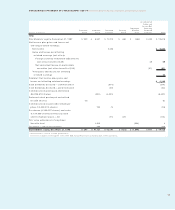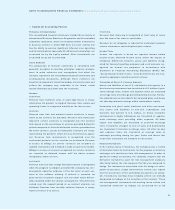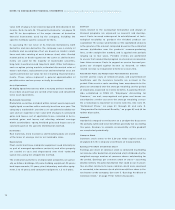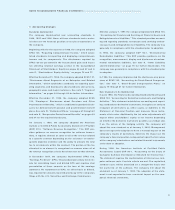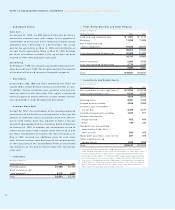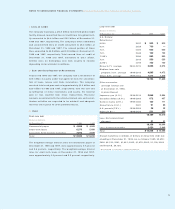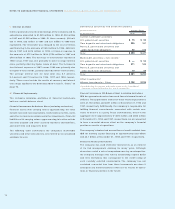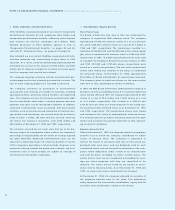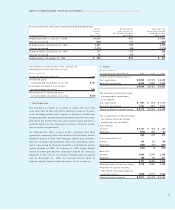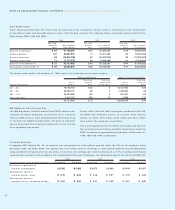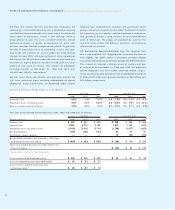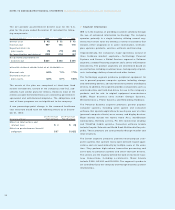IBM 1998 Annual Report Download - page 77
Download and view the complete annual report
Please find page 77 of the 1998 IBM annual report below. You can navigate through the pages in the report by either clicking on the pages listed below, or by using the keyword search tool below to find specific information within the annual report.
NOTES TO CONSOLIDATED FINANCIAL STATEMENTS International Business Machines Corporation and Subsidiary Companies
75
A significant portion of the company’s derivative transactions
relates to the matching of liabilities to assets associated with
both its global financing business and its non-global financing
business. The company issues debt, using the most efficient
capital markets and products, which may result in a currency
or interest rate mismatch with the underlying assets. Interest
rate swaps or currency swaps are then used to match the
interest rates and currencies of its debt to the related assets.
These swap contracts principally mature within five years.
Interest and currency rate differentials accruing under these
interest rate and currency swap contracts are recognized over
the life of the contracts in interest expense.
The company uses internal regional centers to manage the
cash of its subsidiaries. These regional centers principally use
currency swaps to convert cash flows in a cost-effective man-
ner, predominantly for the company’s European subsidiaries.
The terms of the swaps are generally less than one year. The
effects of these contracts are recognized over the life of the
contract in interest expense.
The company also utilizes currency swaps and other foreign
currency contracts in order to hedge the foreign currency
exposures of certain of the company’s net investments in for-
eign subsidiaries. The currency effects of these hedges are
reflected in the Accumulated gains and losses not affecting
retained earnings section of Stockholders’ equity, offsetting a
portion of the translation of net assets.
When the terms of an underlying instrument are modified, or if
it ceases to exist, all changes in fair value of the swap contract
are recognized in income each period until it matures.
Additionally, the company uses derivatives to limit its expo-
sure to loss resulting from fluctuations in foreign currency
exchange rates on anticipated cash transactions among
foreign subsidiaries and the parent company. The company
receives significant intracompany royalties and net payments
for goods and services from its non-U.S. subsidiaries. In antici-
pation of these foreign currency flows, and given the volatility
of the currency markets, the company selectively employs
foreign currency options to manage the currency risk. The
terms of these instruments are generally less than one year.
For purchased options that hedge qualifying anticipated
transactions, gains and losses are deferred and recognized in
net income in the same period that the underlying transaction
occurs, expires or is otherwise terminated. At December 31,
1998 and 1997, there were no material deferred gains or
losses. The premiums associated with entering into these
option contracts are generally amortized over the life of the
options and are not material to the company’s results.
Unamortized premiums are included in prepaid assets. For
purchased options that hedge anticipated transactions which
do not qualify for hedge accounting, gains and losses are
recorded in net income as they occur on a mark-to-market
basis. All written options are marked to market monthly and
are not material to the company’s results.
The company also enters into transactions to moderate the
impact that an appreciation of the dollar relative to other cur-
rencies would have on the translation of foreign earnings.
These transactions do not qualify as hedges for accounting
purposes, and their foreign exchange gains and losses are
recorded in net income as they occur.
The following table summarizes the notional value, carrying
value and fair value of the company’s derivative financial
instruments on- and off-balance sheet. The notional value at
December 31 provides an indication of the extent of the com-
pany’s involvement in such instruments at that time, but does
not represent exposure to market risk.
At December 31, 1998 At December 31, 1997
Notional Carrying Fair Notional Carrying Fair
(Dollars in millions) Value Value Value Value Value Value
Interest rate and currency contracts $«31,484 $«(485) $«(427) $«24,774 $«29 $«÷84
Option contracts 9,021 67 45 14,211 41 193
Total $«40,505 $«(418) $«(382) *$«38,985 $«70 $«277*
Bracketed amounts are liabilities.
*The estimated fair value of derivatives both on- and off-balance sheet at December 31, 1998 and 1997, consists of assets of $486 million and $581 million
and liabilities of $868 million and $304 million, respectively.




